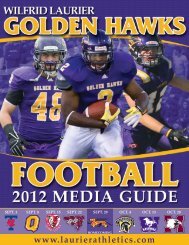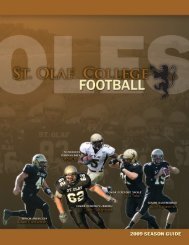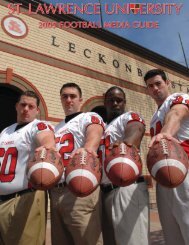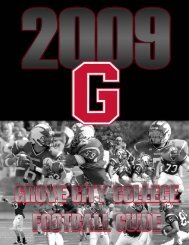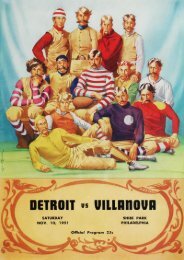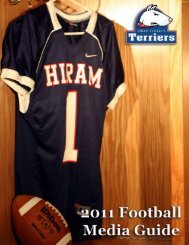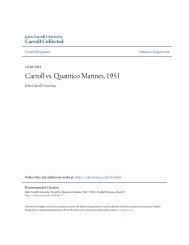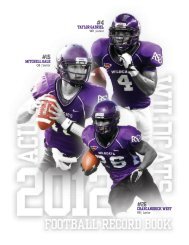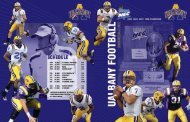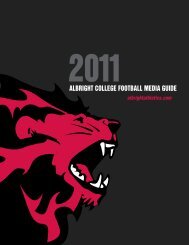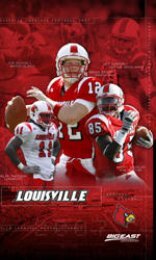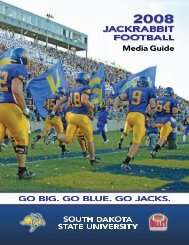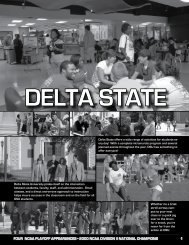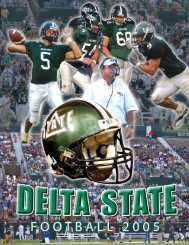- Page 1 and 2: Location: Boulder, Colo. Population
- Page 3 and 4: 2004 COLLEGE BOWL SCHEDULE Date Bow
- Page 5 and 6: include former United States Suprem
- Page 7 and 8: PRESIDENT ELIZABETH HOFFMAN Dr. Eli
- Page 9 and 10: ATHLETIC DIRECTOR DICK THARP Dick T
- Page 11 and 12: great tradition took place on Octob
- Page 13: In the summer of 1976, Folsom Field
- Page 17 and 18: Ensure teams rank consistently amon
- Page 19 and 20: In seven seasons at Northwestern, h
- Page 21 and 22: Gary Barnett / Year-By-Year at Nort
- Page 23 and 24: MIKE HANKWITZ Mike Hankwitz was nam
- Page 25 and 26: DAVE BORBELY Dave Borbely is in his
- Page 27 and 28: TED GILMORE Ted Gilmore is in his s
- Page 29 and 30: CHRIS WILSON Chris Wilson is in his
- Page 31 and 32: DAVID HANSBURG David Hansburg is no
- Page 33 and 34: (Those known as of July 9) ALL-AMER
- Page 35 and 36: The look up front is promising with
- Page 37 and 38: tioned plus grad John Donahoe). The
- Page 39 and 40: ➯ QB JOEL KLATT is 10th in passin
- Page 41 and 42: Buffs & College Football Hardware C
- Page 43 and 44: No. Player Pos. Ht. Wt. Class Exp H
- Page 45 and 46: FRESHMAN RECRUITS 2000 Brandon Dabd
- Page 47 and 48: 78 TERRANCE BARREAU, OG 6-3, 295, S
- Page 49 and 50: Byron White for the second most in
- Page 51 and 52: North Mesquite was 8-2 his senior y
- Page 53 and 54: 25 HUGH CHARLES, RB 5-8, 185, Fr.,
- Page 55 and 56: PASSING RUSHING Season G Att-Com-In
- Page 57 and 58: 98 BRANDON DABDOUB, DT 6-1, 290, Sr
- Page 59 and 60: 44 JORDON DIZON, ATH 6-1, 210, Fr.,
- Page 61 and 62: 22 BYRON ELLIS, TB 6-1, 190, Fr., H
- Page 63 and 64: ACADEMICS— He is majoring in soci
- Page 65 and 66:
CC was 3-7 his sophomore year and 6
- Page 67 and 68:
2002 (Fr.)—Redshirted; did not se
- Page 69 and 70:
Patriot Dream Team honoree. After L
- Page 71 and 72:
PERSONAL—He was born September 3,
- Page 73 and 74:
14 JOEL KLATT, QB 6-1, 200, Jr., 2L
- Page 75 and 76:
house (his mom was a flight attenda
- Page 77 and 78:
60 MATT McCHESNEY, DT 6-4, 290, Sr.
- Page 79 and 80:
ACADEMICS— He is majoring in econ
- Page 81 and 82:
42 BOBBY PURIFY, TB 6-0, 215, Sr.,
- Page 83 and 84:
4 CHRIS RUSSELL, CB 6-3, 185, Fr.,
- Page 85 and 86:
2 CHARLIE SHERMAN III, ATH 6-1, 185
- Page 87 and 88:
HIGH SCHOOL—As a senior, he earne
- Page 89 and 90:
29 JOHN TORP, P 6-2, 200, Jr., 1L L
- Page 91 and 92:
and six rebounds per game as a seni
- Page 93 and 94:
special teams. As a junior, totaled
- Page 95 and 96:
20 TERRY WILSON, CB 5-11, 190, Fr.,
- Page 97 and 98:
Where would you rather play the CU-
- Page 99 and 100:
WALTER BOYE-DOE 2003 Plays UT AT—
- Page 101 and 102:
BRIAN DANIELS 2003 Plays KD TDB PRS
- Page 103 and 104:
CHRIS HOLLIS 2002 Plays UT AT—TK
- Page 105 and 106:
VAKA MANUPUNA 2002 Plays UT AT—TK
- Page 107 and 108:
CLINT O’NEAL 2002 Plays KD TDB DW
- Page 109 and 110:
QUINN SYPNIEWSKI RECEIVING 2000 No.
- Page 111 and 112:
JESSE WALLACE RECEIVING 2001 No. Yd
- Page 113 and 114:
RECENT GAME-BY-GAME LEADERS 2000 Da
- Page 115 and 116:
MISSOURI Game 4 / Sat., Oct. 2 (Col
- Page 117 and 118:
KANSAS STATE Game 10 / Sat., Nov. 1
- Page 119 and 120:
KANSAS STATE (59 games in series, 5
- Page 121 and 122:
TEXAS TECH (7 games in series, all
- Page 123 and 124:
KANSAS STATE Rank CU Rushing Passin
- Page 125 and 126:
1976 CU-Oklahoma State 1995 CU- Tex
- Page 127 and 128:
KANSAS Colorado leads, 39-21-3 (in
- Page 129 and 130:
Oct. 30, 1915 Utah 35- 3 Oct. 28, 1
- Page 131 and 132:
COLORADO 16 UCLA 14 Game Two; Septe
- Page 133 and 134:
FLORIDA STATE 47 COLORADO 7 Game Fo
- Page 135 and 136:
COLORADO 50 KANSAS 47 (OT) Game Six
- Page 137 and 138:
OKLAHOMA 34 COLORADO 20 Game Eight;
- Page 139 and 140:
COLORADO 21 MISSOURI 16 Game Ten; N
- Page 141 and 142:
NEBRASKA 31 COLORADO 22 Game Twelve
- Page 143 and 144:
DEFENSIVE STATISTICS Tackles——
- Page 145 and 146:
FIRST DOWN RUSHING Player Att. Yard
- Page 147 and 148:
MISCELLANEOUS STATISTICS DRIVE ENGI
- Page 149 and 150:
ALL-AMERICAN OG MARWAN HAGE (honora
- Page 151 and 152:
Ralphie II Ralphie III 151 Ralphie
- Page 153 and 154:
Heath Irwin COLORADO By An Opponent
- Page 155 and 156:
COLORADO By An Opponent 500 Yards T
- Page 157 and 158:
(Since 1950, when play-by-plays are
- Page 159 and 160:
RUNNING BACK STARTING DEBUTS Year R
- Page 161 and 162:
(Note: bowl statistics NOT included
- Page 163 and 164:
SCORING Year Player Class TD PAT FG
- Page 165 and 166:
KICKOFF RETURNS Year Player Class N
- Page 167 and 168:
PASS DEFLECTIONS Year Player Class
- Page 169 and 170:
2,000-YARD PASSING SEASONS Kordell
- Page 171 and 172:
100-YARD RUSHING & RECEIVING GAMES
- Page 173 and 174:
RECEIVING (Yards) Rk Player (Season
- Page 175 and 176:
TOTAL OFFENSE Rk Player (Seasons) R
- Page 177 and 178:
TACKLES-FOR-LOSS Rk Player (Seasons
- Page 179 and 180:
RUSHING Yards continued yds (att-td
- Page 181 and 182:
PASSING Yards (all 200-plus yard ga
- Page 183 and 184:
TOTAL OFFENSE Yards (all 300-plus y
- Page 185 and 186:
TACKLES Number Tot (UT-AT) Player O
- Page 187 and 188:
Average Per Reception (minimum 15 r
- Page 189 and 190:
ALL-TIME LONGEST RUSHING PLAYS Yard
- Page 191 and 192:
ALL-TIME LONGEST MISCELLANEOUS RETU
- Page 193 and 194:
Most 100-Yard Rushing Games Consecu
- Page 195 and 196:
Touchdown Passes By Class/Season Fr
- Page 197 and 198:
Most Yards Gained, Opening Game Of
- Page 199 and 200:
Marcus Washington PUNTING Punts Gam
- Page 201 and 202:
DEFENSIVE (from game films where ap
- Page 203 and 204:
Most Touchdowns, Rushing & Passing
- Page 205 and 206:
Scoring Average Highest, Season—4
- Page 207 and 208:
TOTAL DEFENSE/OPPONENT TEAM BESTS P
- Page 209 and 210:
GAME PROGRAMS THROUGH THE YEARS 192
- Page 211 and 212:
DEFENSIVE SINGLE GAME TEAM BESTS FI
- Page 213 and 214:
OFFENSE/COLORADO Total Offense Rank
- Page 215 and 216:
DEFENSE/OPPONENTS Total Offense Ran
- Page 217 and 218:
OFFENSE FIRST DOWNS OPPONENT SINGLE
- Page 219 and 220:
SEASON HOME ATTENDANCE Season Games
- Page 221 and 222:
Harry Heller Eddie Crowder COACHING
- Page 223 and 224:
Conference Overall Record Final Ran
- Page 225 and 226:
LE Dewey C. Bailey Jr. June J. Wils
- Page 227 and 228:
Byron Bradford Ralph Prator C Jere
- Page 229 and 230:
1946 5-4-1 3-2-1 (4th/Mountain Stat
- Page 231 and 232:
1948 3-6-0 2-3 (4th/Big 7) Rank CU
- Page 233 and 234:
1950 5-4-1 2-4 (6th/Big 7) Rank CU
- Page 235 and 236:
1952 6-2-2 2-2-2 (4th/Big 7) Rank C
- Page 237 and 238:
1954 7-2-1 3-2-1 (3rd/Big 7) Rank C
- Page 239 and 240:
1956 8-2-1 4-1-1 (2nd/Big 7) Rank C
- Page 241 and 242:
1958 6-4-0 4-2 (3rd/Big 7 ) Rank CU
- Page 243 and 244:
1960 6-4 5-2 (2nd/Big 8) Rank CU Ru
- Page 245 and 246:
1962 2-8 1-6 (7th/Big 8) Rank CU Ru
- Page 247 and 248:
1964 2-8 1-6 (7th/Big 8) Rank CU Ru
- Page 249 and 250:
1966 7-3 5-2 (2nd/Big 8) Rank CU Ru
- Page 251 and 252:
1968 4-6 3-4 (4th/Big 8) Rank CU Ru
- Page 253 and 254:
1970 6-5 3-4 (4th/Big 8) Rank CU Ru
- Page 255 and 256:
1972 8-4 4-3 (3rd/Big 8) Rank CU Ru
- Page 257 and 258:
1974 5-6 3-4 (5th/Big 8) Rank CU Ru
- Page 259 and 260:
1976 8-4 5-2 (1st/Big 8) Rank CU Ru
- Page 261 and 262:
1978 6-5 2-5 (7th/Big 8) Rank CU Ru
- Page 263 and 264:
1980 1-10 1-6 (7th/Big 8) Rank CU R
- Page 265 and 266:
1982 2-8-1 1-5-1 (6th/Big 8) Rank C
- Page 267 and 268:
1984 1-10 1-6-0 (7th/Big 8) Rank CU
- Page 269 and 270:
1986 6-6 6-1-0 (2nd/Big 8) Rank CU
- Page 271 and 272:
1988 8-4 4-3-0 (4th/Big 8) Rank CU
- Page 273 and 274:
1990 11-1-1 7-0-0 (1st/Big 8) Rank
- Page 275 and 276:
1992 9-2-1 5-1-1 (2nd/Big 8) Rank C
- Page 277 and 278:
1994 11-1 6-1 (2nd/Big 8) Rank CU R
- Page 279 and 280:
1996 10-2 7-1 (2nd/North/Big 12) Ra
- Page 281 and 282:
1998 8-4 4-4 (4th/North/Big12) Resu
- Page 283 and 284:
2000 3-8 3-5 (4th/North/Big 12) Ran
- Page 285 and 286:
2002 9-5 7-1 (1st/North/Big 12) Res
- Page 287 and 288:
Best Record After: Record Times Las
- Page 289 and 290:
COLORADO VS. THE NATION BIG 12 CONF
- Page 291 and 292:
1929 Conference Overall W L T Pts O
- Page 293 and 294:
1991 Conference Overall W L T Pts O
- Page 295 and 296:
Date Record AP Coaches 1996 Preseas
- Page 297 and 298:
1993 (3-3-0) #24 BAYLOR ...........
- Page 299 and 300:
THE BUFFS AND THE WEATHER Colorado
- Page 301 and 302:
Television Appearances, continued D
- Page 303 and 304:
NIGHT GAMES COLORADO VS. NO. 1 TEAM
- Page 305 and 306:
BIG 7/8/12 OPENERS In 56 conference
- Page 307 and 308:
OTHER FOURTH QUARTER WINS/TIES (Gam
- Page 309 and 310:
membership to the whole student bod
- Page 311 and 312:
Oct. 4, 1980—In one of the wildes
- Page 313 and 314:
Oct. 28, 2000—Craig Ochs joins an
- Page 315 and 316:
Eric Bieniemy though the Buffs defe
- Page 317 and 318:
Sept. 24, 1994—Colorado 27, Michi
- Page 319 and 320:
with his natural foot or take a los
- Page 321 and 322:
RETIRED NUMBERS #24 BYRON “WHIZZE
- Page 323 and 324:
Colorado’s Six Unanimous All-Amer
- Page 325 and 326:
OFFENSIVE PLAYER-OF-THE-YEAR (confe
- Page 327 and 328:
BEST INTERVIEW As selected by the C
- Page 329 and 330:
Sept. 26, 1970 DL Herb Orvis (vs. P
- Page 331 and 332:
State Prep Awards Several Buffaloes
- Page 333 and 334:
The University of Colorado selected
- Page 335 and 336:
Justin Bannan Marlon Barnes John Ba
- Page 337 and 338:
Erv Cheney Darrin Chiaverini Shanno
- Page 339 and 340:
Guy Egging Marcellous Elder Jon Emb
- Page 341 and 342:
William Harris Don Hasselbeck Mark
- Page 343 and 344:
Rick Kay Karry Kelley Dan Kelly Mik
- Page 345 and 346:
Eric McCready Brady McDonnell Kanav
- Page 347 and 348:
Pete Perry Rod Perry Tom Perry Bobb
- Page 349 and 350:
Rashaan Salaam Victor Scott Bob Seb
- Page 351 and 352:
Rich Umphrey Mark Vander Poel Ken V
- Page 353 and 354:
1890— C.L. Edmundson John Nixon 1
- Page 355 and 356:
Name (Alma Mater) Position(s) Seaso
- Page 357 and 358:
No. Player, Pos. 46 Ted Johnson, LB
- Page 359 and 360:
Player Pos. Season Games Lee Rouson
- Page 361 and 362:
1963 (4) 70. Dan Grimm, OG, Green B
- Page 363 and 364:
Two-Sport Star Carroll Hardy Dave L
- Page 365 and 366:
NATIONAL FOOTBALL LEAGUE (203 all-t
- Page 367 and 368:
Mark Haynes, DB N.Y. (1980-85), Den
- Page 369 and 370:
Greg Westbrooks, LB New Orleans (19
- Page 371 and 372:
CU & THE NFL: TEAM-BY-TEAM A look a
- Page 373 and 374:
Indianapolis Colts (Baltimore 1953-
- Page 375 and 376:
San Francisco 49ers DRAFT CHOICES P
- Page 377 and 378:
JOHN BAYUK FB, 6-1, 220, 3L, Salida
- Page 379 and 380:
CLIFF BRANCH WR, 5-10, 172, 2L, Hou
- Page 381 and 382:
CULLEN BRYANT DB, 6-1, 220, 3L, Col
- Page 383 and 384:
JOE GARTEN OG, 6-3, 280, 4L, Placen
- Page 385 and 386:
DON HASSELBECK TE, 6-7, 240, 4L, Ci
- Page 387 and 388:
CHRIS HUDSON CB, 5-11, 190, 4L, Hou
- Page 389 and 390:
MARK KONCAR OT, 6-5, 275, 3L, Murra
- Page 391 and 392:
MARK MARISCAL P, 6-2, 200, 3L, Tall
- Page 393 and 394:
HERB ORVIS DE, 6-5, 235, 3L, Petosk
- Page 395 and 396:
MATT RUSSELL ILB, 6-2, 245, 4L, Fai
- Page 397 and 398:
BRYAN STOLTENBERG C, 6-2, 280, 4L,
- Page 399 and 400:
ALFRED WILLIAMS OLB, 6-6, 240, 4L,
- Page 401 and 402:
Class of 1998 Class of 1999 Gil Cru
- Page 403 and 404:
Colorado Bowl Scoreboard (Won 11, L
- Page 405 and 406:
1957 ORANGE BOWL Jan. 1, 1957 at Mi
- Page 407 and 408:
1967 BLUEBONNET BOWL Dec. 31, 1967
- Page 409 and 410:
1970 LIBERTY BOWL Dec. 12, 1970 at
- Page 411 and 412:
1972 GATOR BOWL Dec. 30, 1972 at Ja
- Page 413 and 414:
1977 ORANGE BOWL Jan. 1, 1977 at Mi
- Page 415 and 416:
1986 BLUEBONNET BOWL Dec. 31, 1986
- Page 417 and 418:
1990 ORANGE BOWL Jan. 1, 1990 at Mi
- Page 419 and 420:
1991 BLOCKBUSTER BOWL Dec. 28, 1991
- Page 421 and 422:
1993 ALOHA BOWL Dec. 25, 1993 at Ho
- Page 423 and 424:
1996 COTTON BOWL Jan. 1, 1996 at Da
- Page 425 and 426:
1998 ALOHA BOWL Dec. 25, 1998 at Ho
- Page 427 and 428:
2002 FIESTA BOWL Jan. 1, 2002 at Te
- Page 429 and 430:
INDIVIDUAL Rushing Attempts (Game)
- Page 431 and 432:
ALL-TIME BOWL STATISTICS RUSHING G
- Page 433 and 434:
Charlie Greer .....................
- Page 435 and 436:
COLORADO PERSONNEL HISTORY The Univ
- Page 437 and 438:
KAREN MORRISON Associate Athletic D
- Page 439 and 440:
MIKE SMITH Director of Equipment Mi
- Page 441 and 442:
and then as video production coordi
- Page 443 and 444:
January 2003, when the organization
- Page 445 and 446:
ningest coach in Xavier track & fie
- Page 447 and 448:
ANDREA DUBAY Assistant Trainer Andr
- Page 449 and 450:
GREG FINNEGAN SPEED-STRENGTH & COND
- Page 451 and 452:
KRIS LIVINGSTON Women’s Basketbal
- Page 453 and 454:
Phone Fax E-Mail Title Name (alma m
- Page 455 and 456:
2004 BIG 12 COMPOSITE SCHEDULE Sept
- Page 457 and 458:
Colorado Press Luncheons: Gary Barn
- Page 459 and 460:
Hotels (Boulder) Millennium Harvest
- Page 461 and 462:
THE BUFFS ON LOCAL TV In the fall o
- Page 463 and 464:
therapeutic application. Humerus
- Page 465 and 466:
COLORADO CHAPTER NFF-COLLEGE HOF Th
- Page 467 and 468:
Men’s Basketball (18-11, 10-6 Big



